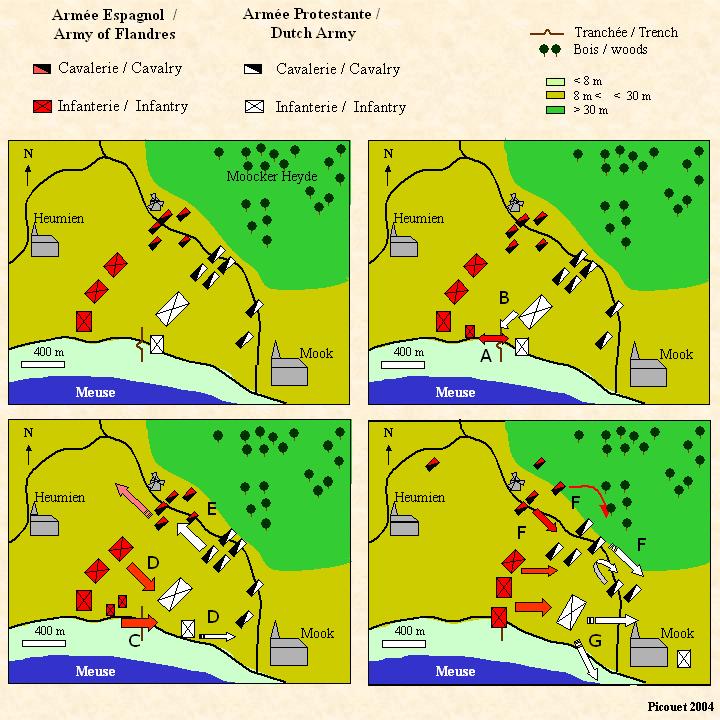
| Dutch Protestant Army Commander: Luis of Nassau Infantry: 5 500 men Cavalry: 2 600 men Losses > 3 000 men |
Army of Flanders
Commander: De Avila Infantry ~ 4 700 men (Spanish Tercio ~ 3100 men) Cavalry ~ 800 men Losses: 150 - 200 men |
Strategic situation : Coming from Germany with 9 000 men, Louis of Nassau wanted to rejoin William of Orange to invade the Brabant and reduce at the same time the pressure on the besiege city of Leyden in Holland. The Spanish Commander organised quickly an army of 6 000 men commanded by Sancho de Avila to march towards Louis of Nassau. With a rapid march the Spanish pass the river Meuse and cut the retreat of the Dutch army. The 14 of April the two vanguards develop a small skirmish near the village of Heumien. Next day, the Dutch are forced to fight a pitch battle near the village of Mook, in a plain between the river Meuse (called Maas in the Nederland) and a wooden area called the Moocker HeydeThe Spanish army was deployed between a wood on his left and the river Meuse on his right. The infantry was deployed in 3 squadrons: 2 Spanish squadrons using some 30 companies from the Tercios of Lombardia, Flanders, Napoles and Sicilia and one Walloon squadron of 16 companies. The Spanish cavalry was organised in 3 Spanish squadrons of lancer (del Monte, Mendoza and ...) with 395 horsemen in total, 1 squadron of 200 reiters (Stenck) and 1 squadron of 170 Harquebusiers on horse in vanguard.
The Dutch protestant army (mainly made of German mercenary) was deployed as follow, on the right 4 cavalry squadrons of 400 men, in the centre an infantry squadron of 25 companies and on the left a small infantry squadron of 10 companies behind a trench. The rest of the Dutch cavalry (2 squadrons) was behind to protect their camp.

| A: At 10 am, the Spanish commander sent a mangas
of 300 harquebusiers (100 Spanish and 200 Walloons) to skirmish with the
Dutch Infantry (in fact German raw recruits) protected by the trench. After
90 min of mutual fire the Spanish took the trench.
B: A counter-attack by the infantry of Nassau repulsed the Spanish from the trench. C: A new detachment of 300 harquebusiers (200 Spanish and 100 Walloons) and 100 Spanish pikemen was sent by Sancho de Avila to reinforce the vanguard. Again, after fierce fighting, the Spanish took the trench and the Dutch run away. D: At the same time the Spanish infantry squadrons advanced to support the vanguard. The Dutch infantry could not stand for long and began to retreat. With great discipline the Spanish Infantry stayed on its position and did not pursuit the enemy. E: The Dutch tried to counter attack with their cavalry to save the day. First they broke the small vanguard of Harquebusiers on Horse and after they managed to beat the German squadron of cavalry, on the right flank who retreated in disorder. F: When most of the Dutch cavalry was reloading their weapons, the Spanish cavalry lancers, supported by harquebusiers on horse, attacked the flanks and the front and broke the Dutch charge. The Dutch horsemen of the first and second line were pressed by the Spanish cavalry and infantry and obliged to retreat from the battlefield. G: Despite a last failed counter attack by their cavalry, the Dutch infantry left alone on the battlefield fled in panic to the rear followed by the Spanish and Walloons, sword in hand. |
Balance: The Dutch army was defeated, they lost 2500 infantrymen, 500 cavalrymen and two of their Leaders Louis of Nassau and Eric of Nassau lied dead on the battlefield. But lack of funds and mutinies would reduce the impact of the Spanish victory and great opportunity to end the war lost. At last the city of Leyde was saved by the flooding of the Spanish camp...